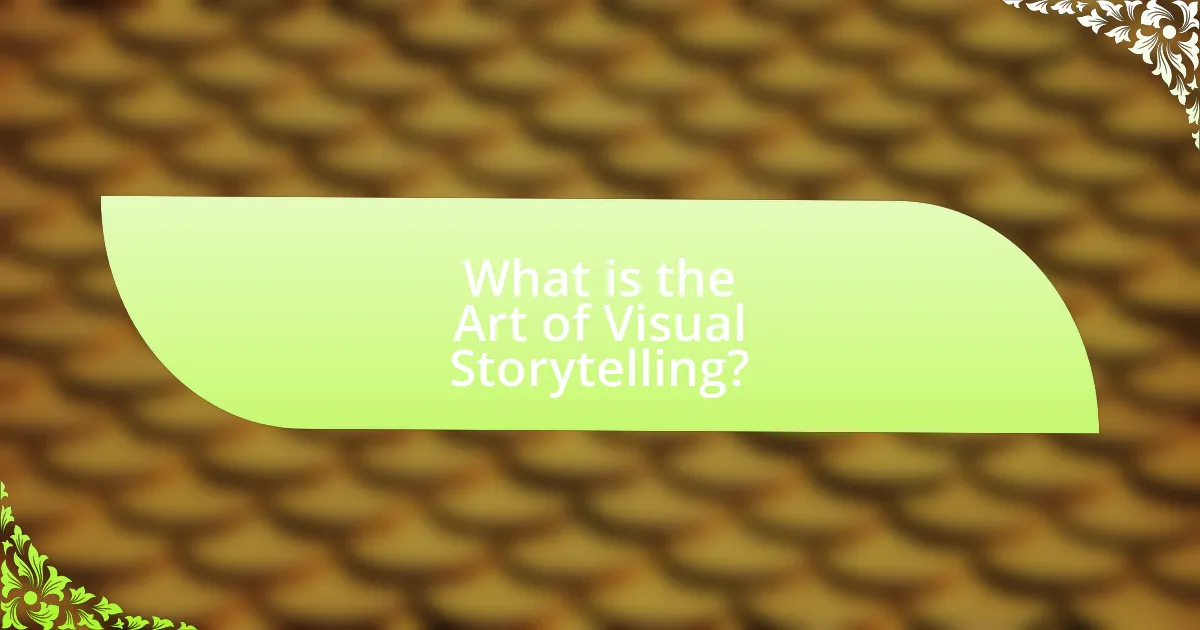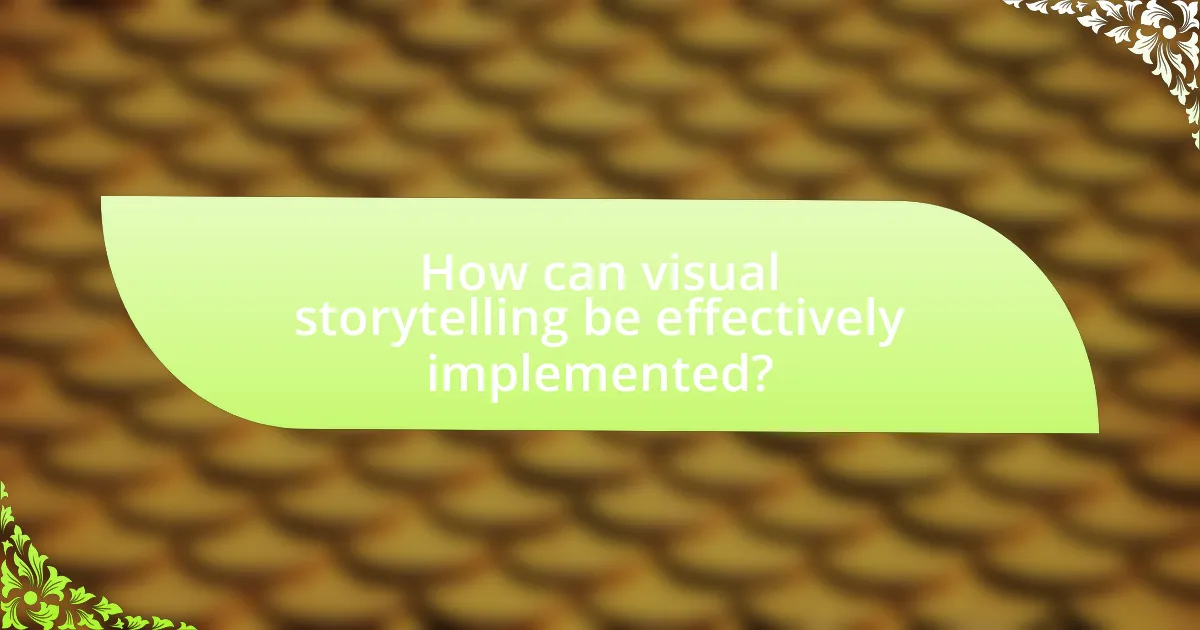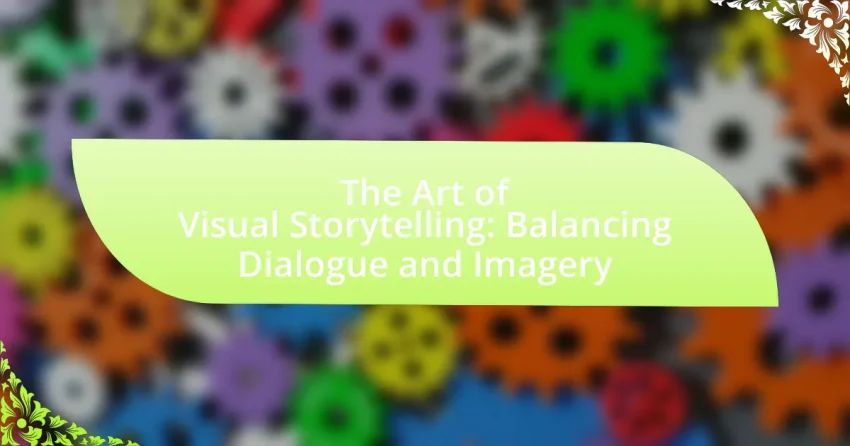The Art of Visual Storytelling focuses on conveying narratives through visual media, such as images and videos, rather than relying solely on text. This article explores the differences between visual and traditional storytelling, emphasizing the importance of imagery, composition, color, and narrative structure in engaging audiences. It discusses the role of dialogue in enhancing visual narratives, the challenges of integrating these elements, and techniques for achieving balance. Additionally, the article highlights best practices for creating compelling visual stories, common pitfalls to avoid, and the significance of audience feedback in refining visual narratives.

What is the Art of Visual Storytelling?
The Art of Visual Storytelling is the practice of conveying narratives through visual media, such as images, videos, and graphics, rather than relying solely on text. This technique engages audiences by combining imagery with minimal dialogue to evoke emotions and communicate messages effectively. Research indicates that visuals can enhance memory retention by up to 65% compared to text alone, demonstrating the power of visual elements in storytelling.
How does visual storytelling differ from traditional storytelling?
Visual storytelling differs from traditional storytelling primarily in its reliance on visual elements to convey narrative, whereas traditional storytelling often emphasizes text and dialogue. In visual storytelling, images, graphics, and visual cues play a central role in communicating emotions, themes, and plot, allowing for immediate audience engagement. For instance, films and graphic novels utilize visuals to create atmosphere and character development, which can evoke emotional responses more quickly than written descriptions. Research indicates that visual information is processed 60,000 times faster than text, highlighting the efficiency of visual storytelling in capturing attention and conveying complex ideas succinctly.
What are the key elements of visual storytelling?
The key elements of visual storytelling include imagery, composition, color, and narrative structure. Imagery serves as the primary medium through which stories are conveyed, utilizing visuals to evoke emotions and convey messages. Composition refers to the arrangement of visual elements within a frame, guiding the viewer’s eye and enhancing the storytelling experience. Color plays a crucial role in setting the mood and tone, influencing the emotional response of the audience. Finally, narrative structure organizes the sequence of events, ensuring a coherent flow that engages viewers and maintains their interest. These elements work together to create a compelling visual narrative that resonates with the audience.
Why is imagery important in storytelling?
Imagery is important in storytelling because it enhances the reader’s experience by creating vivid mental pictures that evoke emotions and stimulate the imagination. This sensory engagement allows readers to connect more deeply with the narrative, making characters and settings more relatable and memorable. Research indicates that stories with strong imagery can improve retention and comprehension, as illustrated by a study published in the journal “Cognitive Science,” which found that visual imagery significantly aids memory recall. Thus, effective use of imagery not only enriches the storytelling experience but also reinforces the audience’s understanding and emotional investment in the story.
What role does dialogue play in visual storytelling?
Dialogue serves as a crucial element in visual storytelling by conveying character emotions, advancing the plot, and providing context. It enhances the audience’s understanding of the narrative and deepens character development, allowing viewers to connect with the story on a more personal level. For instance, in films like “Pulp Fiction,” dialogue not only reveals character motivations but also sets the tone and pacing of the story, demonstrating its integral role in shaping the viewer’s experience.
How can dialogue enhance the visual narrative?
Dialogue enhances the visual narrative by providing context, depth, and emotional resonance to the imagery presented. When characters express thoughts and feelings through dialogue, it allows the audience to understand motivations and relationships, which can deepen their engagement with the visual elements. For instance, in films, dialogue can clarify the story’s themes and character arcs, making the visuals more impactful. Research indicates that effective dialogue can increase viewer retention and emotional response, as seen in studies analyzing audience reactions to films and television shows.
What are the challenges of integrating dialogue with imagery?
Integrating dialogue with imagery presents challenges such as maintaining coherence between visual elements and spoken words. This coherence is crucial because mismatched dialogue and imagery can confuse the audience, leading to misinterpretation of the narrative. For instance, if a character expresses joy through dialogue while the imagery depicts a somber scene, it creates a dissonance that disrupts the storytelling flow. Additionally, the pacing of dialogue must align with visual transitions; rapid dialogue can clash with slow imagery, hindering audience engagement. Effective integration requires careful synchronization of these elements to enhance narrative clarity and emotional impact.
Why is balancing dialogue and imagery crucial?
Balancing dialogue and imagery is crucial because it enhances storytelling by creating a more immersive experience for the audience. When dialogue conveys character emotions and motivations, imagery complements this by providing visual context, allowing readers to visualize scenes and connect emotionally. Research indicates that narratives combining both elements effectively engage readers, as evidenced by studies showing that stories with rich imagery and dialogue lead to higher retention rates and emotional responses. This synergy between dialogue and imagery fosters a deeper understanding of the narrative, making it more impactful.
How does imbalance affect audience engagement?
Imbalance negatively affects audience engagement by creating disconnection between the visual and narrative elements of storytelling. When either dialogue or imagery is overemphasized, it can lead to confusion or disengagement, as audiences may struggle to follow the intended message. For instance, a study published in the Journal of Visual Communication found that narratives with a balanced integration of visuals and text resulted in a 30% higher retention rate among viewers compared to those with significant imbalance. This evidence underscores the importance of maintaining equilibrium in storytelling to enhance audience connection and comprehension.
What techniques can be used to achieve balance?
Techniques to achieve balance in visual storytelling include the use of symmetry, contrast, and the rule of thirds. Symmetry creates a sense of harmony by evenly distributing elements within the frame, while contrast emphasizes differences between dialogue and imagery, drawing attention to key components. The rule of thirds involves dividing the frame into a grid and placing important elements along these lines or their intersections, guiding the viewer’s eye and creating a more engaging composition. These techniques are widely recognized in visual arts and photography, as they enhance the overall effectiveness of storytelling by ensuring that both dialogue and imagery complement each other.

How can visual storytelling be effectively implemented?
Visual storytelling can be effectively implemented by integrating compelling visuals with a coherent narrative that enhances the audience’s understanding and emotional engagement. This approach involves selecting images that complement the story, using visual metaphors, and ensuring that the visuals align with the tone and message of the narrative. Research indicates that visuals can increase information retention by up to 65% when paired with relevant text, demonstrating the effectiveness of this method in communication.
What are the best practices for creating compelling visual stories?
The best practices for creating compelling visual stories include establishing a clear narrative structure, utilizing strong visuals, and engaging the audience emotionally. A clear narrative structure ensures that the story has a beginning, middle, and end, which helps maintain viewer interest. Strong visuals, such as high-quality images or animations, enhance the storytelling by providing context and evoking emotions. Engaging the audience emotionally can be achieved through relatable characters and situations, which fosters a connection between the viewer and the story. Research indicates that stories with emotional resonance are more memorable and impactful, as evidenced by a study published in the journal “Cognitive Science,” which found that emotional narratives are processed more deeply by audiences.
How can one choose the right imagery to complement dialogue?
To choose the right imagery to complement dialogue, one should ensure that the visuals enhance the emotional tone and context of the spoken words. This involves selecting images that reflect the mood, setting, and character dynamics present in the dialogue. For instance, if a character expresses sadness, imagery depicting a gloomy landscape or dim lighting can reinforce that emotion. Research indicates that visuals can significantly impact audience perception; a study published in the Journal of Visual Communication found that congruent imagery increases viewer engagement and emotional response. Therefore, aligning imagery with the dialogue’s emotional and contextual elements is crucial for effective visual storytelling.
What storytelling techniques can enhance visual narratives?
Storytelling techniques that can enhance visual narratives include the use of visual metaphors, pacing, and character development. Visual metaphors allow creators to convey complex ideas through imagery, making the narrative more relatable and impactful. Pacing, achieved through the timing of visual elements and transitions, helps maintain audience engagement and builds tension or emotional resonance. Character development, illustrated through visual cues such as expressions and body language, deepens audience connection and investment in the story. Research indicates that narratives incorporating these techniques can lead to a 30% increase in viewer retention and emotional engagement, as evidenced by studies in visual communication and psychology.
What tools and mediums are available for visual storytelling?
Visual storytelling utilizes various tools and mediums, including photography, video, animation, graphic design, and illustration. Photography captures moments and emotions, while video combines moving images and sound to convey narratives. Animation allows for creative expression through movement and visual effects, making it suitable for storytelling in diverse formats. Graphic design enhances visual communication through layout and typography, and illustration provides a unique artistic interpretation of stories. Each medium serves distinct purposes, enabling storytellers to engage audiences effectively across different platforms.
How do different mediums impact the storytelling process?
Different mediums significantly impact the storytelling process by influencing how narratives are conveyed and experienced. For instance, film utilizes visual and auditory elements to create an immersive experience, allowing for immediate emotional engagement through cinematography and sound design. In contrast, literature relies on descriptive language and the reader’s imagination, enabling deeper internal reflection and interpretation. Research by the University of Southern California highlights that interactive mediums, such as video games, enhance storytelling by allowing players to make choices that affect the narrative outcome, thus fostering a sense of agency. Each medium shapes the pacing, emotional resonance, and audience engagement, demonstrating that the choice of medium is crucial in storytelling effectiveness.
What software or platforms are recommended for visual storytelling?
Adobe Creative Cloud, particularly Adobe Photoshop and Adobe Premiere Pro, is highly recommended for visual storytelling due to their comprehensive tools for image editing and video production. These platforms are widely used in the industry, with Adobe Photoshop being the standard for graphic design and image manipulation, while Adobe Premiere Pro is favored for video editing, allowing creators to combine visuals and narratives effectively. Additionally, platforms like Canva and Storyboard That offer user-friendly interfaces for creating visual content, making them accessible for beginners. These tools support various formats and styles, enhancing the storytelling experience through visuals.

What are common pitfalls in visual storytelling?
Common pitfalls in visual storytelling include overloading visuals with excessive detail, which can distract the audience from the core message. This often leads to confusion and misinterpretation of the narrative. Another pitfall is neglecting the emotional connection; visuals that lack emotional resonance fail to engage viewers effectively. Additionally, poor pacing can disrupt the flow of the story, making it difficult for the audience to follow along. Research indicates that clarity and emotional engagement are critical for effective storytelling, as highlighted in studies on narrative comprehension and audience retention.
What mistakes should be avoided when balancing dialogue and imagery?
When balancing dialogue and imagery, one should avoid overloading scenes with excessive dialogue or overly detailed imagery. Excessive dialogue can detract from the visual elements, making the narrative feel cluttered and reducing the impact of the imagery. Conversely, overly detailed imagery can overshadow dialogue, causing readers to miss essential character interactions and plot developments. Research indicates that effective storytelling requires a harmonious blend of both elements, as seen in successful works where dialogue complements imagery rather than competes with it. For instance, in film and literature, a balanced approach enhances emotional engagement and narrative clarity, demonstrating that moderation is key to effective storytelling.
How can over-reliance on dialogue detract from the visual experience?
Over-reliance on dialogue can detract from the visual experience by overshadowing the imagery that conveys emotions and themes. When a narrative depends heavily on spoken words, it limits the audience’s ability to interpret visual cues, such as facial expressions, body language, and cinematography, which are essential for a rich storytelling experience. Research indicates that visual storytelling engages viewers on a deeper emotional level; for instance, studies show that non-verbal communication can convey complex emotions more effectively than dialogue alone. Therefore, excessive dialogue can lead to a diminished appreciation of the visual elements that enhance the narrative.
What are the consequences of poor imagery in storytelling?
Poor imagery in storytelling leads to a lack of emotional engagement and diminished reader comprehension. When imagery fails to evoke vivid mental pictures, readers struggle to connect with characters and settings, resulting in a flat narrative experience. Research indicates that effective imagery enhances memory retention and emotional response; thus, poor imagery can hinder these cognitive processes, making the story forgettable. For instance, a study published in the Journal of Experimental Psychology found that readers who encountered rich, descriptive language were more likely to recall details and feel emotionally invested in the narrative compared to those exposed to vague descriptions. Therefore, the consequences of poor imagery include disengagement, reduced emotional impact, and impaired memory retention.
How can feedback improve visual storytelling?
Feedback can significantly enhance visual storytelling by providing insights into audience perception and engagement. When creators receive constructive criticism, they can identify which elements resonate with viewers and which do not, allowing for adjustments that improve clarity and emotional impact. Research indicates that iterative feedback loops lead to more refined narratives and visuals, as seen in studies where filmmakers and graphic designers reported increased audience satisfaction after incorporating viewer suggestions. This process not only sharpens the storytelling but also fosters a deeper connection between the creator and the audience, ultimately resulting in more compelling visual narratives.
What role does audience feedback play in refining visual narratives?
Audience feedback plays a crucial role in refining visual narratives by providing insights into how effectively the story resonates with viewers. This feedback allows creators to identify strengths and weaknesses in their visual storytelling, enabling them to make informed adjustments that enhance emotional engagement and clarity. For instance, studies have shown that audience reactions can highlight specific elements, such as pacing or character development, that may require modification to improve overall impact. By analyzing audience responses, creators can iteratively refine their narratives, ensuring that the final product aligns more closely with viewer expectations and preferences.
How can one effectively incorporate critiques into their work?
To effectively incorporate critiques into one’s work, one should actively seek feedback, analyze it objectively, and implement relevant suggestions. Engaging with critiques allows for a deeper understanding of audience perceptions and areas for improvement. For instance, a study by the University of California found that creators who regularly sought and applied feedback improved their work quality significantly, demonstrating the value of constructive criticism in enhancing visual storytelling.
What practical tips can enhance your visual storytelling skills?
To enhance visual storytelling skills, focus on creating a strong narrative structure that combines compelling visuals with clear messaging. This involves selecting images that evoke emotions and support the story, ensuring that each visual element serves a purpose in conveying the overall message. Research indicates that visuals can increase information retention by up to 65% when paired with relevant text, highlighting the importance of alignment between imagery and narrative. Additionally, practicing the use of color theory can significantly impact the mood and tone of the story, as colors can evoke specific feelings and associations.
How can you practice balancing dialogue and imagery in your projects?
To practice balancing dialogue and imagery in your projects, incorporate both elements in a way that complements each other. Start by writing scenes that utilize dialogue to reveal character emotions and motivations while simultaneously using imagery to set the tone and context. For instance, when a character expresses joy through dialogue, describe their surroundings with vibrant imagery that reflects that emotion, such as a sunny day or blooming flowers. This technique enhances the reader’s experience by creating a cohesive narrative. Additionally, analyze successful works in literature and film that exemplify this balance, noting how authors and filmmakers interweave dialogue and imagery to create a rich storytelling experience.
What resources are available for learning more about visual storytelling?
Books, online courses, and workshops are valuable resources for learning about visual storytelling. Notable books include “Understanding Comics” by Scott McCloud, which explores the relationship between images and text, and “The Visual Story” by Bruce Block, which provides insights into visual structure. Online platforms like Coursera and Skillshare offer courses on visual storytelling techniques, often taught by industry professionals. Additionally, workshops hosted by organizations such as the American Society of Media Photographers provide hands-on experience and expert guidance. These resources collectively enhance understanding and skills in visual storytelling.
